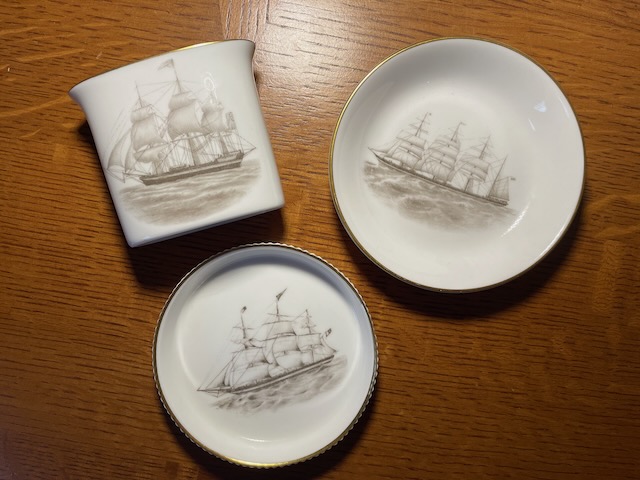Did you, like me, receive a curious set of porcelain knick-knacks that your mom picked up at a charity shop because they had pictures of ships on them? No? OK, well, maybe your mom is different from mine.
But I did get the following three items from my mom, and as you can see by the stickers on the bottom, she found the set for £2, presumably at a charity shop in London or in Wiltshire. Knowing my love of ships, she took them to Seattle, gave them to me as a small Christmas gift, and then I brought them home with me to the Finger Lakes region of New York. Now that they’re here, what could I discover about them?


First, the ship(s). As you can see, the images are of several different ships. The taller piece (perhaps for holdings cigarettes?) has a different image on each side. One image matches the image on the ridged piece, labelled on the bottom as “ARACAN 1854” and displaying a three-masted bark. The back side of the taller piece has a somewhat shorter vessel, with full topsails rather than split topsails. The other piece has an image of a four-masted bark, with no name on the back. Also, all three pieces have the name “Thos. & Jno. Brocklebank Ltd”, a 19th and 20th century shipping line that was acquired by the Anchor Line in 1912, according to Wikipedia.
In the image below, of the two sides of the taller piece, the image on the left, with the flags blowing aft, has got split topsails, and matches the image of the Aracan from the ridged piece. The image on the right shows much larger single topsails on each mast, on what appears to be a different vessel. I guess I don’t know what ship it represents!

To learn more about the one named ship, I went to ShipIndex.org, as one does, and searched for “Aracan”. In the subscription database I found 32 citations from six resources. Some citations have very little information about the specific vessel, like the top two, while others, like the bottom two, have at least a bit more:

The entries from the various shipping registries, as in the bottom viewable entry, are more useful, and from them I can see that Aracan was a bark, and was built in Sundsvall, Sweden, in 1876. The ship’s captain at this time was Capt H.F. Hedberg.

Other entries, though, such as this one from 1875, before the ship was launched, show a different ship — one that was built in 1854, in Whitehaven, England, and registered in Liverpool.

So I can see now that there are at least two ships named Aracan, built nearly 20 years apart.
Given our ability to differentiate between ships of the same name, this is a great opportunity to do just that. I use Wikidata Q-identifiers because I believe they are the best, most shared, most common, and most open, tool for implementing and using Linked Data. So I search Wikipedia for an entry about ships named Aracan, and I find nothing there. That’s not a complete surprise, but it’s a bit disappointing. I check Wikidata for any records of ships named Aracan there, and again come up short:

I can create Wikidata entries for the two Aracans that I now know about, but I really don’t have a lot of information about them. In the grand scheme of things, that really is the correct thing to do – it contributes to the greater good and makes it easier for others to learn more about these specific ships. But I don’t have much detail to add about either ship, and I have a checkered history in creating and editing records in Wikidata and Wikipedia, so I shy away from it, at times. I could perhaps use the image of the 1854 Aracan from this porcelain, but a quick search online indicates that the pieces probably date from the late 1950s so I don’t feel that I can say with certainty (which Wikidata expects) that the image is copyright-free. Perhaps, in the future, I’ll create records for these ships. ShipIndex, though, has the ability to quickly create our own identifiers, which we can use until we find that Wikidata Q-identifiers exist. So, for now, that’s what I’ll do.
I’ll then associate the citations that are clearly about either the 1854 or the 1876 vessels, with those new identifiers, and now the page looks a bit different, with a record of two different ships sharing the same name, and with citations about each one combined together.

If or when Q-identifiers are created for these ships, and if or when images are added to those entries, these ‘cards’ for the two different ships with the same name will add and incorporate those images into this page.
You may not have received a holiday gift with a ship on it, but if you did, see if you can find it it ShipIndex.org!
